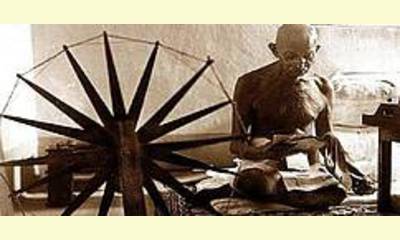|
|
Gandhi’s Legacy Lives On
un article par UNESCO News
Video: Gandhi: "Truth is God"
From Rabindranath Tagore to Mohandas Gandhi to Amartya Sen, great Indian minds have addressed the necessity of holistic education for peace and personal development. This century-long legacy is reflected in the goals of a new UNESCO Institute.

©Gandhi phtosfree- Gandhi Reading after spinning
click on photo to enlarge
The Mahatma Gandhi Institute of Education for Peace and Sustainable Development (MGIEP), to be inaugurated in New Delhi later this year, will be the latest in a long line of initiatives reminding us that Gandhi’s legacy endures.
“If we are to reach real peace in this world and if we are to carry on a real war against war, we shall have to begin with children”. These words were taken to heart by the two followers of India’s Bapu (“Father”) who founded City Montessori School – recipient of UNESCO’s 2002 Prize for Peace Education – which stands as one of many incarnations of the Mahatma’s words: the school’s core philosophy is to make “a good human being, a good member of a family, a good member of a community, a good citizen of a country, a good citizen of the world” out of their pupils via the broadest possible education for tolerance and peace.
Children are also at the centre of programmes such as the “Peace across borders” art workshops which brought together children from India, Bangladesh and Pakistan in the summer of 2011 to paint a peace mural based on the poems of Rabindranath Tagore and Faiz Ahmad Faiz, in the framework of the UNESCO “Rabindranath Tagore, Pablo Neruda, Aimé Césaire: for a reconciled universal” programme.
Gandhi believed that “poverty is the worst kind of violence” – and numerous ongoing education programmes will be essential to helping millions of Indians out of poverty. The Indian government has launched Saakshar Bharat, a five-year flagship literacy programme for 70 million non-literates, the majority of them women. Similarly, many Indian NGOs have pioneered innovative approaches. The Barefoot College in Tilonia, a UNESCO partner, the only school in the world open only to people without any formal education, is explicitly founded on Gandhi’s philosophy of service and sustainability. Nirantar, a women’s organization in Uttar Pradesh, won a UNESCO King Sejong Literacy Prize for its rural fortnightly newspaper produced by low caste women and distributed to more than 20,000 newly literate readers.
According to the Education for All Global Monitoring Report 2010, although India is still some way from reaching all six EFA goals, it has a high chance of achieving Universal Primary Education (UPE) as well as gender parity in primary education by 2015.
It is fitting that an institution placed under the aegis of Mahatma Gandhi should embody the core values he taught and lived by: respect for human rights; equality; tolerance; peaceful exchange and understanding; autonomy; self-empowerment; a more balanced relationship with the environment.
With powerful backing and an extensive mandate, the Institute will carry Gandhi’s legacy forward, leading the new generations along the way.
|








|
DISCUSSION
Question(s) liée(s) à cet article:
What is the message to us today from Mahatma Gandhi?,
* * * * *
Commentaire le plus récent:
Gandhi gives us so many lessons, we should spend our lives learning them. Here are just some examples that have influenced me.
I discovered in the earliest stages that pursuit of truth did not admit of violence being inflicted on one's opponent but that he must be weaned from error by patience and sympathy.
In fact, Gandhi teaches us that there are no enemies, only opponents whom we have yet to convince of the truth. And what is truth?
Gandhi teaches us that truth is a mountain:
There are many paths to Truth, many relative truths, many diverse paths or ways to climb the mountain.
I think of this lesson when I meet others whose path I do not understand at first. Are there places where our paths cross as we climb the mountain?
Hate the sin but not the sinner
We must never reject the person, but rather criticize their actions if we think they are harmful and try to change their behavior. Again, no one is our enemy, even if they are in conflict with us. It is a question of trying to understand and transform the conflict. And what should be our motivation? Why not anger?
I have learned through bitter experience the one supreme lesson to conserve my anger, and as heat conserved is transmitted into energy, even so our anger controlled can be transmitted into a power that can move the world.
Anger is the natural human response to injustice; Let us learn from the child who cries out in frustration: "That's not fair!"

|
|









